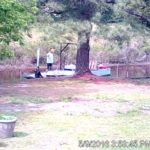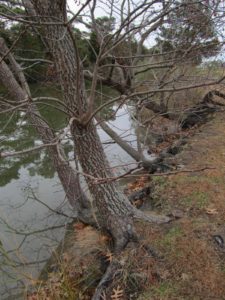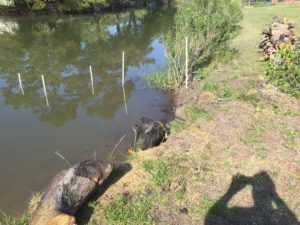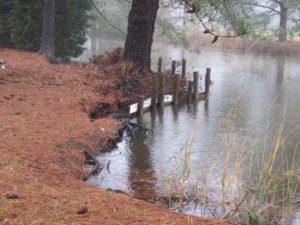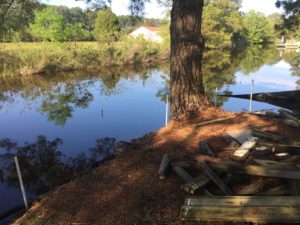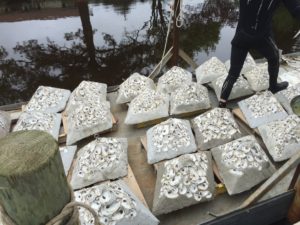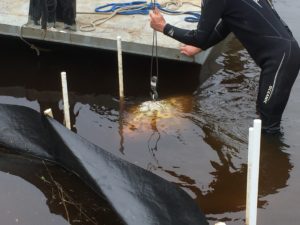This year we decided to take a slightly different approach to our charitable giving, while not a tax deductible contribution we will be giving back to the community and the environment and helping to clean both Doctors Creek and the Chesapeake Bay.
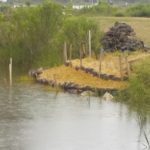
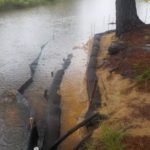
Update: All Oyster Reefs are installed and the shore work has been completed creating a 10:1 slope in an effort to rebuild the shoreline to help wit erosion. The grasses have been planted.
While we are back in Richmond (5/9/2016) work continues on the Oyster Reef with additional modules being placed.
Work began this week on the installation of the 182-feet of Oyster Reef on Monday, May 2, 2016.
| 5/5/2016 | 5/5/2016 |
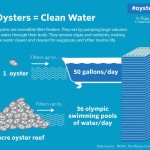 Oyster habitat is vital to the health of an estuary, effectively filtering nutrients, algae, bacteria, fine sediments and toxins from the water and improving water quality. A typical adult oyster filters between 20 and 50 gallons per day! When fully populated with oysters, the constructed reefs will be able to filter the total volume of an Estuary in about one month. Clearer water allows for more sunlight penetration which can lead to expansion of seagrass beds.
Oyster habitat is vital to the health of an estuary, effectively filtering nutrients, algae, bacteria, fine sediments and toxins from the water and improving water quality. A typical adult oyster filters between 20 and 50 gallons per day! When fully populated with oysters, the constructed reefs will be able to filter the total volume of an Estuary in about one month. Clearer water allows for more sunlight penetration which can lead to expansion of seagrass beds.
Oyster reefs provide important forage and refuge habitat for over 300 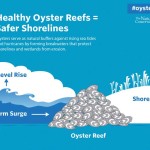 species of invertebrates, such as shrimp, crabs, clams, snails and worms, as well as many species of fish such as snook, grouper, redfish, black drum and more. Many fish species that live as adults on the offshore reefs spend the juvenile phase of their life on oyster reefs.
species of invertebrates, such as shrimp, crabs, clams, snails and worms, as well as many species of fish such as snook, grouper, redfish, black drum and more. Many fish species that live as adults on the offshore reefs spend the juvenile phase of their life on oyster reefs.
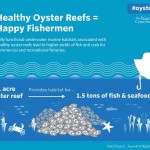 Oysters also support critical fisheries and when coupled with other coastal restoration efforts such as mangrove and spartina plantings, restored oyster reefs can also serve as effective shoreline buffers.
Oysters also support critical fisheries and when coupled with other coastal restoration efforts such as mangrove and spartina plantings, restored oyster reefs can also serve as effective shoreline buffers.
Oysters are an indicator species, meaning that their presence in the water can be used to gather information on the overall health of the estuary. Within the last sixty years, the oyster coverage that was historically present in the two estuaries has declined by as much as 75 percent. Restoration efforts that can increase the oyster population help to improve the overall ecological health of the river.
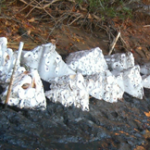
We have approvals from the Mathews County Wetlands Board (2/3/2016), the US Army Corp of Engineers (USACE) (2/8/2016)and are awaiting the final sign-off by the Virginia Marine Resource Commission (VMRC).
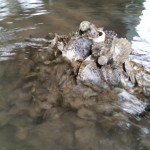
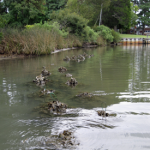
The work and permitting is being done by ReadyReef and they will be placing the reefs in the April timeframe. After the completion of the reef, Readyreef will seed the reef with Oyster Spat and they should begin the process of cleaning the creek as they grown, multiply and create a living reef.
FAQ:
The life cycle of the oyster begins with a free-swimming larval stage that eventually attaches to a hard substrate forming an oyster spat. The spat commences a growth period that is classified into sub-adult and adult phases.
What do oysters eat in the ocean?
Oysters are filter feeders, drawing water in over their gills through the beating of cilia. Suspended plankton and particles are trapped in the mucus of a gill, and from there are transported to the mouth, where they are eaten, digested, and expelled as feces or pseudofeces.
How long do oysters live?
How long can an oyster live? 20-30 years, depending on the species, sometimes longer depending on the Body of Water and the algae it consumes. I have a picture me holding a Kumamoto over 40 years old, weighing in at over fifteen pounds- it’s used exclusively for stock- an oyster “Stud,” for lack of better term.
Do all oysters produce pearls?
Although clams and mussels can also produce pearls, they don’t do so very often. Most pearls are made by oysters, and they can be made in either freshwater or saltwater environments. As oysters grow, an internal organ called the mantle uses minerals from the oyster’s food to produce a substance called nacre.

